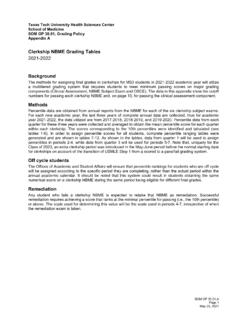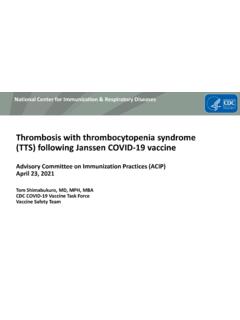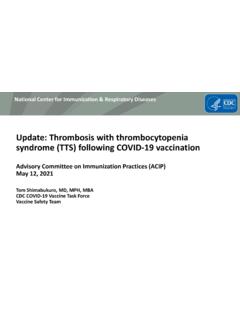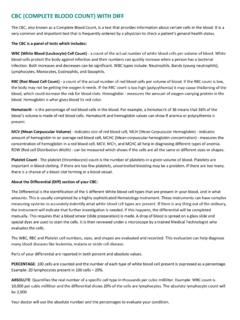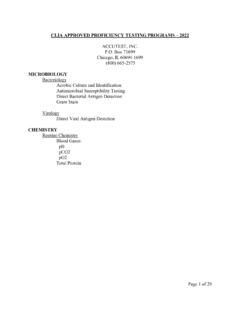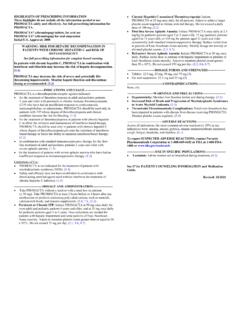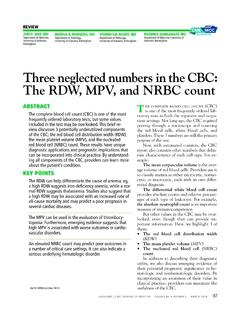Transcription of ROTEM Analysis delta platelet EN 2016-09-website
1 Guide ROTEM Analysis - 09-2016 2 IntroductionIn this text, the basis of ROTEM Analysis is described together with itsuse during the management of acute bleeding. The management of acute bleeding is a complex challenge. Little that isdone in this area is fulfilling the hard criteria of evidence based recommendations in this compendium are based on the experienceof the authors and on the discussion with centres, which use theROTEM system in clinical routine. However, these recommendationshave not yet been prospectively validated. Causes of Haemostasis Disorders Haemostasis disorders can have several causes. Rather chronicprocesses (such as comorbidities of the haemostasis-related organsliver - kidney - bone marrow) or hereditary diseases can be differentiatedfrom more acute alterations due to trauma, haemodilution and thecurrent treatment.
2 The resulting alterations affect the plasmaticcoagulation factors, platelets and the fibrinolytic system. Bleeding most frequently occurs during and after surgical interventionsor traumas, in situations where trauma and secondary alterations( due to haemodilution) are added to the disposition of the such complex haemostasis disorders, the clinical significance ofthe routine parameters PT, aPTT and platelet count is rather weak. Thisleads to the interest in laboratory methods, which better reflecthaemostasis during these complex processes. A. Calatzis, W. Schramm, M. Spannagl. Management of Bleeding in Surgery and Intensive Care. I. Scharrer / W. Schramm (Ed.), 31 st Hemophilia Symposium Hamburg 2000, Springer Verlag Berlin Heidelberg Guide ROTEM Analysis - 09-2016 Alterations of haemostatic causesTrauma and coagulopathy as a cause of bleeding Guide ROTEM Analysis - 09-2016 4 ThromboelastometryDr.
3 Andreas Calatzis, Prof. Dr. Michael Spannagl, Dr. Matthias VorwegTargeted Treatment of Bleeding Events During acute bleeding, a multitude of different therapeutic options are atdisposition to the physician. The difficulty is to choose the rightmedication at the right time and to evaluate how much, respectively howoften, the respective therapeutic option has to be applied. Typically, onlythe right therapy will stop the bleeding. It will be of little use to the patient,if he is transfused with FFP while he is bleeding because ofthrombocytopenia or hyperfibrinolysis. Although this sounds self-evident, in the clinical everyday routine, a "blind" therapy is often means that different medication and blood products areadministered consecutively until the bleeding stops.
4 If the cause of thebleeding is not the most obvious, unnecessary medication and bloodproducts are administered. Thus, unnecessary costs are created and thepatient is exposed to potentially harmful preparations. TEG / ROTEM - History Thrombelastography was developed during world war II by professor in Heidelberg. Following a quite broad application in the 50's and60's, the interest in TEG decreased in the 70's. In the 80's it came to arenaissance of TEG, especially in the United States, because of theapplication in anaesthesia for the management of acute bleeding. TheROTEM system is an enhancement of thrombelastography and wasdeveloped during 1995-1997 in Munich. The instrument includes fourmeasurement channels for simultaneous determinations, an integratedcomputer for automatic Analysis and an electronic pipette for interactivetest operation.
5 Note: The term "TEG" was introduced by Hartert in his first publicationon thrombelastography in 1948. Surprisingly, in 1993, an Americancompany obtained a trade mark on this term in the USA, after 45 yearsof its use as a generic medical term. In order to achieve a globaluniformity of the name, the manufacturer of the ROTEM system (TemInnovations GmbH, Munich) has renamed its instrument from "ROTEG"into " ROTEM " and the tests accordingly from "EXTEG" into "EXTEM","INTEG" into "INTEM" etc. in 2003. "TEM" thereby stands for"thromboelastometry" (analogous to the term "thromboelastography"),thus the plotting of the clot Guide ROTEM Analysis - 09-2016 Bleeding: Therapeutical optionsROTEM Thromboelastometry system 4 channels for simultaneous assays Automated testing in ROTEM sigma, standardized electronic pipetting for ROTEM deltaROTEM delta ROTEM sigma Guide ROTEM Analysis - 09-2016 6 ROTEM thromboelastometry detection methodIn the ROTEM system, the sample is placed into a cuvette and acylindrical pin is immersed.
6 Between pin and cuvette remains a gap of 1mm, which is bridged by the blood or the blood clot. The pin is rotated bya spring alternating to the right and the left. As long as the blood is liquid,this movement is unrestricted. As soon as the blood clots, the clotrestricts the rotation of the pin increasingly with rising clot , the rotation of the pin is inverse proportional to the clot is detected optically. An integrated computer calculates the ROTEM curve as well as its numerical parameters. In contrast, in the TEG according to Hartert, the cuvette is rotated. Thepin is suspended freely from a thin wire and does not move until a clotforms. Because of this free suspension of the pin, the TEG according toHartert is quite susceptible to vibration and mechanical shocks.
7 Due to the mechanical measurement principle of ROTEM Analysis ,blood or plasma can be analysed likewise. This is advantageous for thepoint-of-care application, as centrifugation of the sample is omittedthere. The parameters of ROTEM thromboelastometry Analysis For historical reasons, the curve is plotted two-sided, expressed in mm. CT (clotting time): time from start of the measurement until initiation of clotting o initiation of clotting, thrombin formation, start of clot polymerisation CFT(clot formation time): time from initiation of clotting until a clot firmness of 20 mm is detected o fibrin polymerisation, stabilisation of the clot with thrombocytes and FXIIIMCF(maximum clot firmness): firmness of the clot o increasing stabilisation of the clot by the polymerised fibrin, thrombocytes as well as FXIII ML (maximum lysis).
8 Reduction of clot firmness after MCF in relation to MCF o stability of the clot (ML< 15%) or fibrinolysis (ML > 15% within 1h) 7 Guide ROTEM Analysis - 09-2016 ROTEM thromboelastometry detection methodROTEM thromboelastometry parameters and scaling Guide ROTEM Analysis - 09-2016 8 ROTEM thromboelastometry tests In the past, the thrombelastogram was analysed using freshly drawnblood without the addition of any citrate / calcium and without anyactivators. The measurements were therefore very time consuming (45 -60 min.) and quite unspecific. With the ROTEM , activated determinations are usually performed. Asin the laboratory coagulation Analysis , various activators or inhibitors areadded to the sample, in order to represent different processes ofhaemostasis.
9 For the Analysis , citrated blood is usually used. In EXTEM, coagulation is activated by a small amount of tissuethromboplastin (tissue factor). This typically leads to the initiation of clotformation within 70 seconds. Thus, clot formation can be assessedwithin 10 minutes. In INTEM, coagulation is activated via the contact phase (as in the aPTTand ACT). The INTEM is therefore sensitive for factor deficiencies of theintrinsic system ( FVIII) and for the presence of heparin in thesample. In FIBTEM, coagulation is activated as in EXTEM. By the addition ofcytochalasin D, the thrombocytes are blocked. The resulting clot istherefore only depending on fibrin formation and fibrin polymerisation. In APTEM, coagulation is also activated as in EXTEM.
10 By the addition ofaprotinin or tranexamic acid in the reagent, fibrinolytic processes areinhibited in vitro. The comparison of EXTEM and APTEM allows for arapid detection of fibrinolysis. Furthermore, APTEM enables theestimation if an antifibrinolytic therapy alone normalises the coagulationor if additional measures have to be taken ( administration offibrinogen). In HEPTEM, coagulation is activated as in INTEM. The addition ofheparinase in the reagent degrades heparin present in the sample andtherefore allows the ROTEM Analysis in heparinised typeTest name for each reagent typeSingle UseEXTEM SFIBTEM S APTEM SINTEM SHEPTEM SLiquidEXTEM (L) FIBTEM APTEM INTEM HEPTEM CartridgeEXTEM CFIBTEM C APTEM CINTEM CHEPTEM C9 Guide ROTEM Analysis - 09-2016 ROTEM thromboelastometry tests EXTEM (L, S, C): activation of clot formation by thromboplastin (tissue factor).

